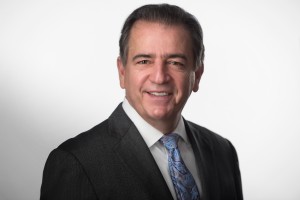Joseph Campanelli
Title: President and CEO, Needham Bank
Age: 61
Experience: 35 years in banking
When the board of directors at Needham Bank began the hunt for a new CEO following the announcement that Mark Whelan would retire, they began a national search, meeting with highly qualified candidates from all over the country. But they didn’t need to look far. The board selected Joseph Campanelli, a Wellesley resident, graduate of nearby Babson College and a lifetime banker. Campanelli, who started with the bank in January, came to Needham after beginning his career at Hartford National Bank and holding various positions at FleetBoston, which was eventually acquired by Bank of America. After Fleet, Campanelli served as CEO and director of Sovereign Bank, now Santander, from 2006 to 2008, and then as chairman and CEO of Michigan-based Flagstar Bank from 2009 to 2012. Since coming aboard, Campanelli has created a new executive team at Needham, and like most community bank CEOs, is busy navigating the waters of a booming Greater Boston market and a low-interest rate environment.
You can watch the interview here.
Q: You have worked at many different banks in a lot of diverse markets. What do you like about Needham Bank?
A: I thought long and hard about what I wanted to do for my next step. At first I thought I might start a bank de novo or raise capital and buy a few troubled banks. But when you look at the reality of opening a bank de novo, it takes three or four years to get scale, which is what you want if you are going to be an innovator in the market and be full service.
Someone mentioned to me that I should be talking to the folks in Needham. I said, “Well, I know where that is, it’s 2.8 miles from my house, that’s not too bad.” I looked at Needham as being the true mission of a community bank because it makes the communities we live in stronger. Being $2 billion in asset size is plenty of scale. The bank has a quarter of a billion dollars in capital so we have plenty of capacity to make good loans, as well as the ability to grow. We are also operating in one of the best markets in the country, if not the world, when you look at diversification and quality of life.
All those things put together, it’s a great opportunity. Its small enough that all I need to do is get 200 people rowing in the same direction and we can do a lot of amazing things, but big enough that we’ve got the depth and breadth to add new products and services.
Q: What is the purpose of the new executive management team you recently established and what do you hope they will accomplish?
A: Needham has a great legacy and a fantastic reputation. It’s grown from a few hundred million to $2 billion in assets, but now we want to take it to the next level and accelerate how quickly we can develop programs. New Chief Administrative Officer and Executive Vice President Sal Rinaldi initially came on and helped us – every company when you grow like we have, you have some growing pains and you need to invest in operations to make them a little more streamline. Sal got to know the rest of the executive management team for a few months and a lot of our senior executives told me, “We have to get this guy full time.”
Sal has worked with me over 35 years. We built a lot of businesses together and he understands how it all fits together from a regulatory standpoint, from an operational and technological standpoint and from a staffing and profitability standpoint. Sal was a new hire, but the other major lines of businesses are run by a diverse team of executives who make up the rest of the new team, who have been here far longer than I have been. We have a lot of good ingredients here.
Q: Needham Bank has a very strong residential loan portfolio, but has also experienced growth in commercial. What products from the bank are having success right now?
A: We are predominantly what you call a purchase house bank. Most of our loans on the residential side are for people buying new homes, either stepping up a notch or downsizing. The good news is we have population growth here, which is great because household formation is what drives housing demand, so that business will continue to do well in good times and bad. When rates go up it affects the cost of homeownership, but so does the economic environment.
We have a great product where we realized a lot of people moving into the area want new amenities. They want fiber optic-wired houses, flat screen TVs and a lot of the housing stock is old here, having been built in the 1960s and 1970s, so we came out with a product called the construction to permanent loan. If there is a couple that comes in and says “We need a room for a nanny,” we say, “We will make you a construction loan, go through the renovation process with you and as soon as we’re done, we will convert it into a permanent mortgage.” It’s been well received and it’s pretty unique in the market. We have taken that innovation and are applying it to other markets.
We are known as the builder’s bank. That’s how much work we do with the trades. That is why we open at 7 a.m. and we are planning to do the same with commercial and industrial loans. The economy continues to grow and expand, so there are all sorts of opportunities.
Q: Where does the bank plan to focus loan growth in the future?
A: We have a very strong residential program that is also expanding to consumer banking, home equity and different types of installment lending, so we can really make our branches full service to give the consumer a broader product set, whether you need a bridge loan or a line of credit. We are looking at every aspect of our business and saying, “How can we make it better? How do we take great niches we have like construction to permanent loans and real estate, and do the same thing even within our C&I business?”
We don’t do a lot of loans through the Small Business Administration; we can do a lot more. We are noticing that all our main streets, whether in Ashland or Millis or here in Needham, are being revitalized. It’s a resurgence of small businesses. And the same goes in Boston. A lot of small businesses are women- and minority-owned, which we know we can do a lot more with.
Campanelli’s Five Ways To Lead:
- Don’t shoot the messenger … unless they are late.
- Managers are appointed; true leaders rise to the occasion.
- Lead, follow or get out of the way.
- A committed team player trumps a star athlete any day.
- You don’t need a bigger boat, you just need everyone to row in the same direction.




 |
| 


